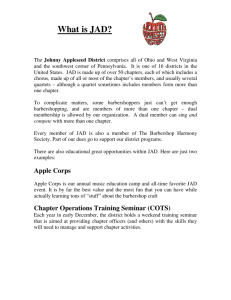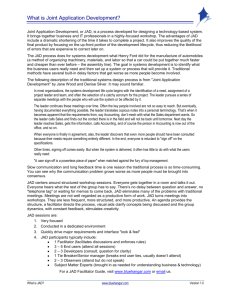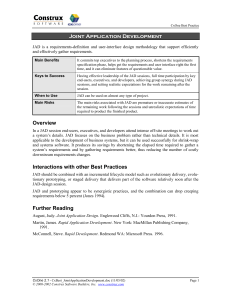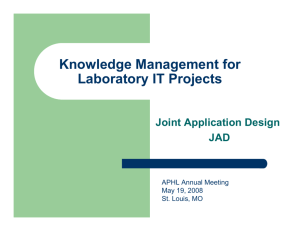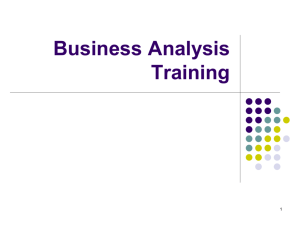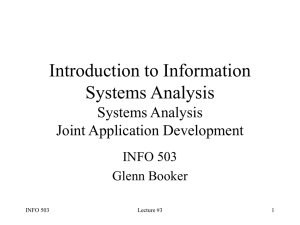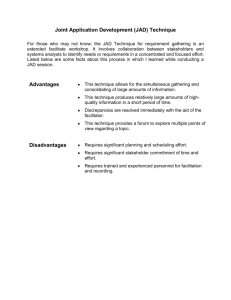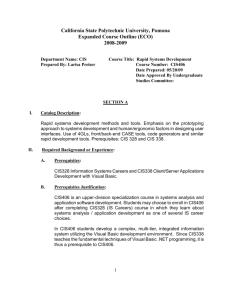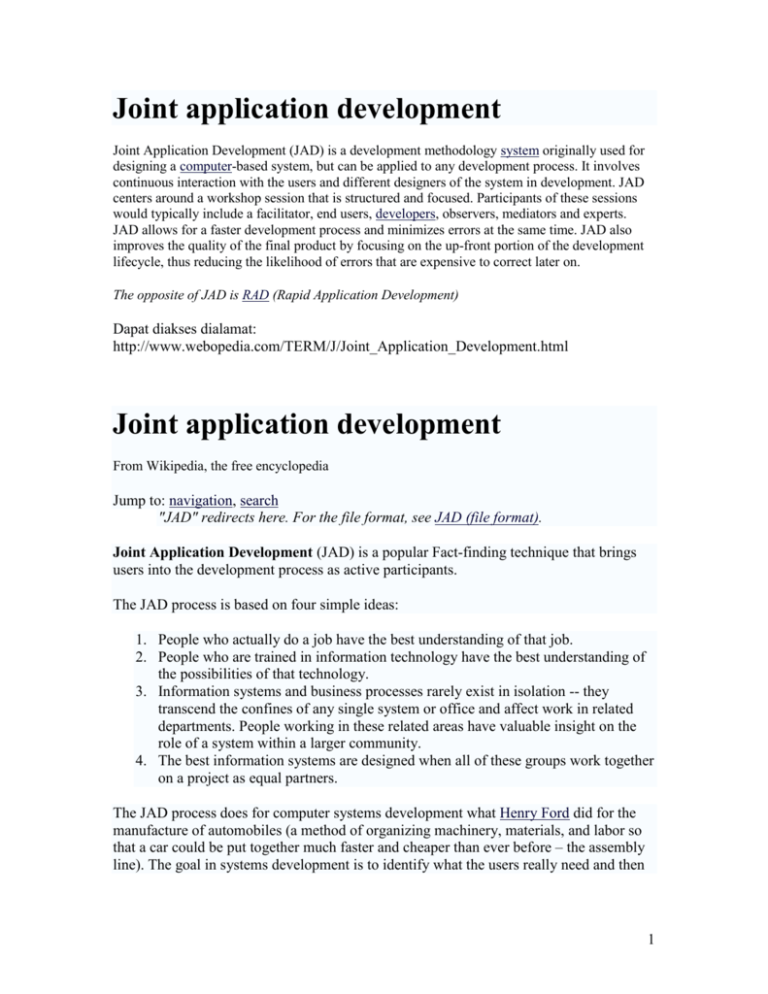
Joint application development
Joint Application Development (JAD) is a development methodology system originally used for
designing a computer-based system, but can be applied to any development process. It involves
continuous interaction with the users and different designers of the system in development. JAD
centers around a workshop session that is structured and focused. Participants of these sessions
would typically include a facilitator, end users, developers, observers, mediators and experts.
JAD allows for a faster development process and minimizes errors at the same time. JAD also
improves the quality of the final product by focusing on the up-front portion of the development
lifecycle, thus reducing the likelihood of errors that are expensive to correct later on.
The opposite of JAD is RAD (Rapid Application Development)
Dapat diakses dialamat:
http://www.webopedia.com/TERM/J/Joint_Application_Development.html
Joint application development
From Wikipedia, the free encyclopedia
Jump to: navigation, search
"JAD" redirects here. For the file format, see JAD (file format).
Joint Application Development (JAD) is a popular Fact-finding technique that brings
users into the development process as active participants.
The JAD process is based on four simple ideas:
1. People who actually do a job have the best understanding of that job.
2. People who are trained in information technology have the best understanding of
the possibilities of that technology.
3. Information systems and business processes rarely exist in isolation -- they
transcend the confines of any single system or office and affect work in related
departments. People working in these related areas have valuable insight on the
role of a system within a larger community.
4. The best information systems are designed when all of these groups work together
on a project as equal partners.
The JAD process does for computer systems development what Henry Ford did for the
manufacture of automobiles (a method of organizing machinery, materials, and labor so
that a car could be put together much faster and cheaper than ever before – the assembly
line). The goal in systems development is to identify what the users really need and then
1
set up a system or process that will provide it. Traditional methods have several built-in
delay factors that get worse as more people become involved.
[edit] Typical session agenda:
Project leader:
1. Introduce all JAD team members
2. Discuss ground rules, goals, and objectives for the JAD sessions
3. Explain methods of documentation and use of CASE tools, if any
Top management (sometimes called the project owner or sponsor): Explain the
reason for the project and express top management authorization and support.
Project Leader:
1. Provide overview of the current system and proposed project scope and
constraints
2. Present outline of specific topics and issues to be investigated.
Open discussion session, moderated by project leader:
1. Review the main business processes, tasks, user roles, input, and output
2. Identify specific areas of agreement or disagreement
3. Break team into smaller groups to study specific issues and assign group leaders.
JAD team members working in smaller group sessions, supported by IT staff:
1. Discuss and document all system requirements
2. Develop models and prototypes.
Group leaders:
1. Report on results and assigned tasks and topics
2. Present issues that should be addressed by the overall JAD team
Open discussion session, moderated project leader:
1. Review reports from small group sessions
2. Reach consensus on main issues
3. Document all topics
Project leader:
1. Present overall recap of JAD session
2. Prepare report that will be sent to JAD team members
2
[edit] Advantages and disadvantages
Compared with traditional methods, JAD may seem more expensive and can be
cumbersome if the group is too large relative to the size of the project. Many companies
find, however, that JAD allows key users to participate effectively in the requirements
modeling process. When users participate in the systems development process, they are
more likely to feel a sense of ownership in the results, and support for the new system.
When properly used, JAD can result in a more accurate statement of system
requirements, a better understanding of common goals, and a stronger commitment to the
success of the new system.
JAD
- JAD (Joint Application Development) is a methodology that involves the client
or end user in the design and development of an application, through a succession of
collaborative workshops called JAD sessions. Chuck Morris and Tony Crawford, both of
IBM, developed JAD in the late 1970s and began teaching the approach through
workshops in 1980.
The JAD approach, in comparison with the more traditional practice, is thought to lead to
faster development times and greater client satisfaction, because the client is involved
throughout the development process. In comparison, in the traditional approach to
systems development, the developer investigates the system requirements and develops
an application, with client input consisting of a series of interviews.
A variation on JAD, rapid application development (RAD) creates an application more
quickly through such strategies as using fewer formal methodologies and reusing
software components.
LAST UPDATED: 26 Feb 2003
3
JAD Documentation dapat sumber didapat dari:
http://www.bee.net/bluebird/jaddoc.htm
Joint Application Design
Business Requirements Analysis for Successful Reengineering
by Bill Jennerich
Today's business organizations have to cope with shorter product life
cycles and demands for higher customer service levels. Firms that take
too long to deliver products or provide products of unacceptable
quality are doomed to failure.
Corporate Information Services (IS) departments are businesses too.
Many of them are in trouble because they are unable to respond
quickly to senior executives' needs for applications and information.
Companies have automated many manual processes over the years to
increase efficiency. However, these systems only support the routine
operational needs of the company. Now, companies need applications
that cross functional boundaries and provide higher-level management
information and decision support to senior executives who need help to
respond to new customer demands.
Progressive organizations are looking beyond simply patching up the
way they do business. They are re-engineering their business processes
to change dramatically the way they operate and the products they
provide. Progressive IS departments are also changing by taking
advantage of new tools and new techniques to re-engineer the way they
build systems.
Development Life Cycle
As a business, the IS department's primary function is to manufacture
and support products called information systems for its customers
called users. The manufacturing process, planning, analysis, design,
development, and maintenance, traditionally has been called the
"systems development life cycle."
The classical systems development life cycle specifies the sequence of
activities required to take an IS application concept through design and
development to successful deployment. This is a sequence of steps and
procedures that we all learned about years ago. I imagine that we all
feel pretty guilty that we've not followed this life cycle as well as we
should have. But we will, on our very next development project, if we
have the time.
Unfortunately, pure development projects are few and far between
4
these days. In most of our shops, up to 90% of our time is spent in
maintenance of existing applications. We spend more time patching
new functionality into old systems than we do designing new systems
to replace the old ones.
Missing the Mark
Unfortunately, pure development projects are few and far between
these days. In most of our shops, up to 90% of our time is spent in
maintenance of existing applications. We spend more time patching
new functionality into old systems than we do designing new systems
to replace the old ones.
So where has this classical systems development life cycle gotten us?
Let's review some industry statistics:
60% of large systems projects have significant cost overruns,
75% of completed systems are in need of constant
maintenance,
60% to 80% of errors originate in the user requirements and
functional specifications.
A survey conducted by the Index Group of Cambridge Massachusetts
in early 1990 concluded that "Systems developers are operating amid
turf battles, historical bickering, low credibility and the difficulty in
pinning down ever-changing systems requirements." Their survey of
95 systems development directors found that:
64% say that they cannot get users in different departments to
cooperate in cross-functional systems projects,
78% say that coordinating efforts between end user developers
and professional systems developers is a major challenge even
though the number of end users developing their own systems
is on the rise,
less than 29% say they have any long-range plans for retiring
obsolete systems.
These statistics reflect the "state of the art" in software systems
development in large organizations today. We might be tempted to say
that it's different in small organizations. Yes, it probably is different,
but likely no better. The information needs of large organization have
hit smaller companies as well. For example:
We've all got a need to develop strategic systems that support
users in multiple functions.
The need for cross-functional strategic applications makes it
more difficult to get users to agree to and sign-off on system
5
specifications.
At the same time, tools are maturing that can help us develop
and implement applications faster than ever before.
In "real life" systems development, time and effort are heavily skewed
towards coding. We feel the need to get started writing the code so we
can get it done in time to allow us to debug the system before we
implement it.
This often results in poor planning feeding inadequate design that does
not meet business needs and requires major revisions and difficult
maintenance over the life of the system. To complicate matters, we've
got application systems that have been in production, in some cases,
for over 15 years. Each year those creaky old systems get harder and
harder to maintain and modify.
Today's Environment
Computer-Aided Software Engineering (CASE) tools are available
today to help us develop applications very quickly. Along with the
tools, the industry has evolved new views of the traditional systems
development life cycle.
The Information Engineering proponents have re-defined and
simplified the life cycle to 4 phases: Planning, Analysis, Design, and
Construction. Other methodologies have defined similar phases.
The one thing all of today's development methodologies agree upon is
that we need to improve the quality of the input - the user
requirements. Requirements must be defined and specified in a
consistent, repeatable, and structured way.
Consequently, the heart of the IS business has moved up the life cycle.
Today we must focus more on analysis and design and less on the
traditional "nuts and bolts", the coding and the implementation tools.
That means to develop effective information systems today we must
take the time to integrate the technical aspects of information
technology and the social aspects of the organization.
To determine user requirements today, we must adopt more effective
techniques that recognize both the differences in communications
styles of our colleagues in the company and the differences in
application requirements of the business functions that we serve. One
such technique is Joint Application Design (JAD).
6
What is JAD?
Joint Application Design is a management process - a people process which allows IS to work more effectively with users in a shorter time
frame. Since the late seventies, JAD has proven to be an effective
technique for building user commitment to the success of application
systems through their active participation in the analysis of
requirements and the specification of the system design.
The facilitated JAD workshop brings key users (stakeholders) and
systems professionals together to resolve their differences in a neutral,
non-hostile atmosphere. Key to the workshop is a specially trained,
unbiased facilitator who is not a member of the project team and
therefore has no political stake in the outcome of the workshop. The
workshop will build a team that will stay together, psychologically at
least, for the life of the project.
The power of JAD is in the integration of behavioral and group
dynamics techniques within the structure of a soundly engineered
methodology. What does that mean? It means that a JAD workshop is
not just a nice meeting.
The workshop has a highly structured agenda with clear objectives
including a mechanism for resolving open issues that often bog down
the design process. The deliverables are clearly defined during the preworkshop activities so that there can be a smooth and successful
transition to the next phase in the life cycle - application design or
acquisition.
Workshops are effective at all levels: enterprise, business area,
application, and implementation project management. Facilitated
workshops can be used whenever a group of diverse individuals needs
to reach a workable consensus. Today, workshops are commonly used
for strategic business planning, strategic IS plans, IS architecture
definition, re-engineering business processes, detailed system design,
process and data modeling, and project management.
This positive, team-building environment gives people a chance to
learn from each other and to understand each other's needs and
concerns. The participants will develop a common view of the project
and a common language to discuss the project issues.
A Common Language
We need a common language so that we can understand each other's
concerns - not the broad issues that are obvious to everyone, but the
7
subtleties that give individual business functions that extra edge.
Users know what they want but they don't have a way to articulate the
subtleties of their business needs so that IS can understand them and
build working systems to support them effectively.
Different functional units have different ways of operating, of making
decisions, and of analyzing what's going on around them. Finance and
accounting people, for instance, tend to be very "cut and dried" or
mechanistic in the way they analyze a problem and judge the merits of
a proposed solution. For an accountant, 2 plus 2 is always 4. A lot of
systems people think like accountants. We like to work towards that
one right answer.
Marketing people, on the other hand, are more willing to work with
abstractions and uncertainties. Consequently, they can be more
frustrating for IS to deal with. They tend to see many shades of gray.
What's 2 plus 2 in the marketing department? "Well, it depends, are we
buying or are we selling."
Today we need applications that cross functional boundaries and
provide high-level management information and decision support to all
of our top executives, to help them respond to the changing business
environment.
However, as we move up the corporate ladder, there is a greater
tendency towards a more open, organic, and adaptive view. That
means that there may not be one right answer. Instead, we may need to
choose among a group of not wrong answers to find the one that best
fits the organizations culture, business, and marketplace. That means
it's harder to get upper management to express their needs in terms that
systems people can understand.
The common language developed in the facilitated JAD workshop
helps all the participants com- municate and understand each other's
needs so that IS can build systems that more effectively support the
company's higher-level information needs.
Pre-Workshop Activities
Good preparation is key to success. There is between one and three
weeks of work required to prepare for a workshop. That preparation is
required to:
1) Identify project objectives and limitations
It is vital to have clear objectives for the workshop and for the project
as a whole. The pre-workshop activities, the planning and scoping, set
8
the expectations of the workshop sponsors and participants.
Scoping identifies the business functions that are within the scope of
the project. It also tries to assess both the project design and
implementation complexity.
The political sensitivity of the project should be assessed. Has this
been tried in the past? How many false starts were there? How many
implementation failures were there?
Sizing is important. For best results, systems projects should be sized
so that a complete design - right down to screens and menus - can be
designed in 8 to 10 workshop days.
2) Identify critical success factors.
It is important to identify the critical success factors for both the
development project and the business function being studied. How will
we know that the planned changes have been effective? How will
success be measured? Planning for outcomes assessment helps us
judge the effectiveness and the quality of the implemented system over
its entire operational life.
3) Define project deliverables
In general, the deliverables from a workshop are documentation and a
design. It is important to define the form and level of detail of the
workshop documentation. What types of diagrams will be provided?
What type or form of narrative will be supplied?
It is a good idea to start using a CASE tool for diagraming support
right from the start. Most of the available tools have good to great
diagraming capabilities but their narrative support is generally weak.
The narrative is best produced with your standard word processing
software.
4) Define the schedule of workshop activities
Workshops vary in length from one to five days. The initial workshop
for a project should not be less than three days. It takes the participants
most of the first day to get comfortable with their roles, with each
other, and with the environment. The second day is spent learning to
understand each other and developing a common language with which
to communicate issues and concerns. By the third day, everyone is
working together on the problem and real productivity is achieved.
After the initial workshop, the team-building has been done. Shorter
workshops can be scheduled for subsequent phases of the project, for
instance, to verify a prototype. However, it will take the participants
from one to three hours to re-establish the team psychology of the
initial workshop.
5) Select the participants
These are the business users, the IS professionals, and the outside
9
experts that will be needed for a successful workshop.
6) Prepare the workshop material
Before the workshop, the project manager and the facilitator perform
an analysis and build a preliminary design or straw man to focus the
workshop. The workshop material consists of documentation,
worksheets, diagrams, and even props that will help the participants
understand the business function under investigation.
7) Organize workshop activities and exercises.
The facilitator must design workshop exercises and activities to
provide interim deliverables that build towards the final output of the
workshop. The pre-workshop activities help design those workshop
exercises. For example, for a Business Area Analysis, what's in it? A
decomposition diagram? A high-level entity-relationship diagram? A
normalized data model? A state transition diagram? A dependency
diagram? All of the above? None of the above? It is important to
define the level of technical diagraming that is appropriate to the
environment. The most important thing about a diagram is that it must
be understood by the users.
Once the diagram choice is made, the facilitator designs exercises into
the workshop agenda to get the group to develop those diagrams.
A workshop combines exercises that are serially oriented to build on
one another, and parallel exercises, with each sub-team working on a
piece of the problem or working on the same thing for a different
functional area.
High-intensity exercises led by the facilitator energize the group and
direct it towards a specific goal. Low-intensity exercises allow for
detailed discussions before decisions. The discussions can involve the
total group or teams can work out the issues and present a limited
number of suggestions for the whole group to consider.
To integrate the participants, the facilitator can match people with
similar expertise from different departments. To help participants learn
from each other, he can mix the expertise. It's up to the facilitator to
mix and match the sub-team members to accomplish the
organizational, cultural, and political objectives of the workshop.
A workshop operates on both the technical level and the political level.
It is the facilitator's job to build consensus and communications, to
force issues out early in the process. There is no need to worry about
the technical implementation of a system if the underlying business
issues cannot be resolved.
8) Prepare, inform, educate the workshop participants
All of the participants in the workshop must be made aware of the
objectives and limitations of the project and the expected deliverables
of the workshop.
10
Briefing of participants should take place 1 to 5 days before the
workshop. This briefing may be teleconferenced if participants are
widely dispersed.
The briefing document might be called the Familiarization Guide,
Briefing Guide, Project Scope Definition, or the Management
Definition Guide - or anything else that seems appropriate. It is a
document of eight to twelve pages, and it provides a clear definition of
the scope of the project for the participants.
The briefing itself lasts two to four hours. It provides the psychological
preparation everyone needs to move forward into the workshop.
9) Coordinate workshop logistics
Workshops should be held off-site to avoid interruptions. Projectors,
screens, PCS, tables, markers, masking tape, Post-It notes, and lots of
other props should be prepared.
What specific facilities and props are needed is up to the facilitator.
They can vary from simple flip charts to electronic white boards. In
any case, the layout of the room must promote the communication and
interaction of the participants.
The Key Players
1) The Facilitator
The facilitator is in charge of the workshop - the guardian of the
process. It is the facilitator's responsibility to ensure that the expected
workshop deliverables are produced and the expected consensus is
achieved. The facilitator is an unbiased leader who has no ties to the
project. He can come from some other department or from outside the
company. Some companies are training facilitators who work out of a
facilitation center attached to the human resources department.
The ideal facilitator is an individual who is excited by working with
people. That would include only between 10% and 15% of senior
systems analysts. Good facilitators often come from non-computer
science fields such as teaching or sales. In addition to an aptitude for
working with people, the facilitator must have the skills required to
achieve the level of analysis detail expected from the workshop. That
means training in the following areas: the methodology (such as
Information Engineering) that will be used in development, group
dynamics, basic selling skills, issue recognition, and listening skills.
Good facilitators listen, recognize issues as they arise, and provide the
leadership and direction to help people come together.
The facilitator is responsible for ensuring that each person is heard and
has an equal opportunity to influence the decision. The facilitator is
also responsible for ensuring that the participants in the workshop
construct a solution that everyone can live with.
11
2) Documentation Expert
This individual has to document the decisions and the issues in the
workshop - to act as a scribe.
3) The Executive Sponsor
This is the executive who charters the project - the system owner. The
sponsor must be high enough in the organization to be able to clear the
calenders of the people required in the workshop. The sponsor
provides motivation for commitment through a short speech at the
opening of the workshop and has to be available for strategic direction
and scoping information during the pre-workshop phase. During the
workshop, the executive sponsor must be available for policy decisions
appropriate for his level of authority.
Without the executive sponsor's commitment, people do not show up
for workshops on time or sometimes at all. Schedules change and
projects are delayed. In short, without an executive sponsor, there is no
project!
4) The Project Manager
This is the person responsible for the project who will work closely
with the facilitator. The project manager, as the client of the workshop
process, receives the deliverables.
5) Business Users
These are the intended users of the system being designed. They are in
the workshop because of their business expertise. Business users fall
into 2 categories: real end users - the people who are actually going
the have to use the screens and reports to do their jobs; and
representative end users - the people who think they know what's
going on in the field. They are responsible for standards and
methodology for the business functions they represent.
It is important to get both types of users into the workshop. If the
workshop consists of only representative users, then we get good
theoretical model - how things should be - but the theories may not
work in practice. If we have only real end users, then we get a good
system for today but it might not work next year or two years down the
road.
6) Systems Experts
The workshop is trying to establish rapport and communications
among stakeholders - including IS. Systems people need to be there to
know the constraints so they can advise the business people regarding
hardware and software under discussion. A good rule of thumb is one
12
systems person for every four users.
7) Outside Experts
Outside experts are business consultants or technology consultants
who can provide the expertise that may not be available in-house. For
example, the workshop may need support from outside consultants for
manufacturing, distribution, marketing, prototyping, organizational
dynamics, and change management.
8) Observers
Observers are not allowed to participate in the workshop in any way.
They may observe to gain some insight into the business area under
investigation or to become familiar with the workshop process.
Post-Workshop Activities
After the workshop, it is important to address and resolve the open
issues generated by the workshop. A three-day workshop typically
generates about 20 open issues, most of which are business issues. It is
critical to get these issues out on the table for discussion and resolution
before any code gets written.
The facilitator and the documentation expert work together to finalize
the workshop documentation. The project manager is the client who
receives the deliverables.
The documentation moves forward through the organization to
continue to enroll support and approvals for the development project if
necessary.
The design moves forward either for inclusion in a request for proposal
for application software acquisition or towards a prototype or a code
generation phase. It may contain details such as screen layouts and
menus. The data model will contain volumes and capacities. The
process model will specify transaction volumes.
If the design is taken into a prototype, there should be a series of 1/2day or one-day workshops to evaluate and validate the prototype.
Workshop Benefits
1) Builds consensus and ownership The workshop approach will
quickly achieve consensus and commitment among users - the
customers of the IS function.
2) Improves design quality
The workshop improves the quality of the deliverable of the design
phase because it forces a definition of that deliverable in advance.
13
During the workshop the participants are all focused on a common
goal. Users in the workshop will have a better understanding of the
business issues, the systems issues, and the volume of work to be done.
3) Project teams get focused and stay focused
In the workshop, the participants will build a common view of the
project and a common language to discuss the issues. These elements
will stay with the team for the life of the project.
4) A natural partnership with modern development tools JAD
helps realize the full potential of today's powerful development tools
by providing high-quality input requirements quickly.
5) 20% reduction in overall life cycle costs
In 1989, computer industry productivity expert, Capers Jones, studied
60 development projects and found:
Without JAD, 35% of the functionality was missed and that had
an impact on at least 50% of the code - core functionality was
missed.
With JAD, less than 10% of the functionality was missed and
that had a minimal impact on the code - indicating that the core
functionality was good but refinement was going on. JAD
doesn't stop refinement - it helps manage it better. Those
projects that used JAD combined with prototyping, did even
better!
Conclusion
The information needs of our top executives are not well defined. The
business climate is uncertain and changing. There is no single right
answer, there is no single right system.
Progressive systems departments are taking advantage of new tools
and new techniques to re-engineer the way they build systems. There
are new development tools, new methodologies and supporting
techniques such as Joint Application Design for developing the
requirements specifications for the systems our users need.
To develop effective information systems today we must take the time
to integrate the technical aspects of information technology and the
social aspects of the organization. That's what facilitated workshop
requirements analysis is all about!
14
Recommended Reading
1. Programming Productivity
by Capers Jones; McGraw Hill.
2. Systems Analysis and Design
3.
4.
5.
6.
by James C. Wetherbe; West Publishing, 1988.
Exploring Requirements: Quality Before Design
by Donald C. Gause and Gerald M. Weinberg; Dorset House Publishing,
1989.
The Fifth Discipline: The Art & Practice of The Learning Organization
by Peter M. Senge; Doubleday/Currency, 1990
Information Engineering:
Book 1: Introduction
Book 2: Planning & Analysis
Book 3: Design & Construction
by James Martin; Prentice Hall, 1990.
Up and Running: Integrating Information Technology and the Organization
by Richard E. Walton; Harvard Business School, 1989.
Adapted by the author from his article in UNISPHERE, Nov 1990
P.O. Box 740908, Dallas, TX 75374-0908
(214) 669-9000
Reprinted with permission. All rights reserved.
Free subscription information available upon request.
We appreciate your comments and observations. If you have
questions or would like more information, please contact the author
at:
Bluebird Enterprises Inc.
357 Beechwood Road
Berwyn, PA 19312-1063
Telephone: 610-647-8662 Fax: 610-647-7796
15
Metodologi Pengembangan
Joint Application Development
Sumber dapat lihat di : http://www.credata.com/research/jad.html
Joint Application Development, or JAD, is a process originally developed for designing a
computer-based system. It brings together business area people (users) and IT
(Information Technology) professionals in a highly focused workshop. The advantages of
JAD include a dramatic shortening of the time it takes to complete a project. It also
improves the quality of the final product by focusing on the up-front portion of the
development lifecycle, thus reducing the likelihood of errors that are expensive to correct
later on.
The JAD process does for computer systems development what Henry Ford did for the
manufacture of automobiles (a method of organizing machinery, materials, and labor so
that a car could be put together much faster and cheaper than ever before – the assembly
line). The goal in systems development is to identify what the users really need and then
set up a system or process that will provide it. Traditional methods have several built-in
delay factors that get worse as more people become involved.
The following description of the Traditional Systems Design process is from "Joint
Application Development" by Jane Wood and Denise Silver ¹. It may sound familiar.
In most organizations, the systems development life cycle begins with the identification
of a need, assignment of a project leader and team, and often the selection of a catchy
acronym for the project. The leader pursues a series of separate meetings with the people
who will use the system or be affected by it.
The leader continues these meetings over time. Often the key people involved are not so
easy to reach. But eventually, having documented everything possible, the leader
translates copious notes into a personal terminology. That’s when it becomes apparent
that the requirements from, say Accounting, don’t mesh with what the Sales department
wants. So the leader calls Sales and finds out the contact there is in the field and will not
be back until tomorrow. Next day the leader reaches Sales, gets the information, calls
Accounting, and of course the person in Accounting is now out of the office, and so on.
When everyone is finally in agreement, alas, the leader discovers that even more people
should have been consulted because their needs require something entirely different. In
the end, everyone is reluctant to "sign off" on the specifications.
16
Other times, signing off comes easily. But when the system is delivered, it often has little
to do with what the users really need:
"A user sign off is a powerless piece of paper"² when matched against the fury of top
management.
Slow communication and long feedback time is one reason the traditional process is so
time-consuming. You can see why the communication problem grows worse as more
people must be brought into consensus.
JAD centers around a structured workshop session. Everyone gets together in a room and
talks it out. Everyone hears what the rest of the group has to say. There’s no delay
between question and answer, no "telephone tag" or waiting for memos to come back.
JAD eliminates many of the problems with traditional meetings. Meetings are not well
regarded as a productive form of work. JAD turns meetings into workshops. They are less
frequent, more structured, and more productive. An agenda provides the structure, a
facilitator directs the process, visual aids clarify concepts being discussed and the group
dynamics, with constant feedback, stimulates creativity.
JAD sessions are:
1.
2.
3.
4.
Very focused
Conducted in a dedicated environment
Quickly drive major requirements and interface "look & feel"
JAD participants typically include:
o Facilitator – facilitates discussions, enforces rules
o End users – 3 to 5, attend all sessions
o Developers – 2 or 3, question for clarity
o Tie Breaker – Senior manager. Breaks end user ties, usually doesn’t attend
o Observers – 2 or 3, do not speak
o Subject Matter Experts – limited number for understanding business &
technology
¹ Wood, J. and D. Silver, Joint Application Development, 2nd ed., New York : Wiley,
1995.
² Wetherbe, James C., "Executive Information Requirements: Getting It Right", MIS
Quarterly, March 1991, p. 51.
17
RESUME
Joint Application Development (JAD)
Adalah suatu teknik pegembangan Aplikasi yang melibatkan antara pemakai dan
profesional dalam pengembangan sistemnya, Teknik JAD dapat diterapkan disetiap tahap
pengembangan sistem
JAD merupakan sebuah teknik yang berfokus pada keterlibatan dan komitmen pengguna
dalam menentukan kebutuhan dan merancang (desain) aplikasi. JAD biasanya dilakukan
dalam bentuk tim yang merupakan gabungan dari seluruh stakeholder proyek, yang
bekerja dalam bentuk workshop-workshop atau forum diskusi. Kenapa workshop ?
karena teknik JAD ini bukanlah sekedar rapat-rapat, yang biasa dilakukan dalam sebuah
proyek dan melibatkan seluruh stakeholder proyek. JAD adalah tim yang nantinya akan
membuat rancangan dan mengawasi, memonitor bersama jalannya proyek.
JAD adalah suatu metodologi pengembangan sistem yang mula-mula digunakan untuk
merancang suatu sistie yang berbasis-komputer, tetapi dapat diberlakukan bagi setiap proses
pengembangan yang
melibatkan interaksi berkelanjutan dengan para pemakai dan para
perancang yang berbeda sistim di dalam pengembangan.
JAD memjadikan
suatu
pengembangan yang lebih cepat memproses dan memperkecil error pada waktu yang sama.
JAD juga memperbaiki mutu produk akhir dengan mengutamakan bagian user/pemakai dalam
bagian pengembangan lifecycle, selain itu dengan JAD akan mengurangi kemungkinan dari error
yang fatal, dapat membuat suatu sistem menjadi mahal jika terjadi perubahan dikemudian hari.
Proses JAD didasarkan pada empat gagasan yang sederhana:
1. Menempatkan Orang-orang yang benar-benar ahli dalam pekerjaanya.
2. Orang-orang yang terlatih di dalam teknologi informasi mempunyai pemahaman terbaik
dalam pengembangan ini.
3. proses-proses Sistem Informasi dan bisnis, Orang-orang yang bekerja di dalam bidangbidang yang terkait mempunyai pengertian yang mendalam dan perang yang berharga
dari suatu sistim dan di dalam suatu masyarakat yang lebih besar.
4. Sistem informasi terbaik dirancang ketika semua kelompok bekerja bersama-sama di
suatu proyek sebagai mitra yang sama.
18
Siapa saja yang perlu terlibat ?
Secara garis besar yang perlu terlibat adalah :
1. Sponsor. Sponsor ini berarti project owner, memiliki kedudukan yang cukup
tinggi dalam organisasi dan sebagai pengambil keputusan tertinggi dalam
pengelolaan sistem informasi. Satu hal yang penting dilakukan oleh seorang
project owner adalah komitmen yang kuat akan implementasi SI yang dilakukan.
Without the executive sponsor’s commitment, people do not show up for
workshops on time or sometimes at all. Schedules change and projects are
delayed. In short, without an executive sponsor, there is no project!
2. Business Users. Business User ini terdiri dari 2 jenis, yaitu real end user dan
representative end user. Real end user adalah person yang melakukan pekerjaan
real di lapangan. Dalam kasus, ini adalah operator-operator. Sedangkan
representative end user adalah person yang mengetahui seharusnya bisnis proses
itu dilakukan, memahami spirit dan goal dari sistem yang dikelolanya. Biasanya
ini adalah kepala bagian, manajer, atau operator senior.
3. System Analyst (Tim Developer). Person/tim ini yang akan in-charge dari sisi
teknologi dan proses engineeringnya.
4. System Experts. Tidak semua referensi mencantumkan peran ini. Perannya lebih
seperti konsultan yang memahami seluk beluk bisnis proses dari sisi konseptual
dan berbasis pengalaman.
5. Facilitator. Seorang fasilitator berfungsi sebagai moderator dan mengarahkan
setiap aktivitas JAD yang melibatkan banyak pihak, untuk menjadi efektif.
Seorang fasilitator harus memiliki kecakapan yang baik dalam berkomunikasi,
memberikan stimulus-stimulus dan trik-trik agar diskusi bisa berjalan dengan
baik.
Tentu saja, setelah penyusunan tim JAD, diperlukan strategi yang tepat dalam melakukan
workshop-workshop, sehingga proses dilakukan lebih efektif. Yang jelas, teknik ini
19
sudah terbuktif efektif dalam menyelesaikan masalah-masalah implementasi SI. Satu
paragraf terakhir dari salah satu referensi adalah sebagai berikut :
To develop effective information systems today we must take the time to integrate the
technical aspects of information technology and the social aspects of the organization.
That’s what facilitated workshop requirements analysis is all about!
Referensi :
1. Development Methodology - Joint Application Development (JAD)
2. Joint Application Development
3. Joint Application Design - Business Requirements Analysis for Successful Reengineering
4. Joint Application Development (JAD) - What do you really want?
Semua Materi ini dapat di Download di
http://sms.unikom.ac.id/taryana/
20

